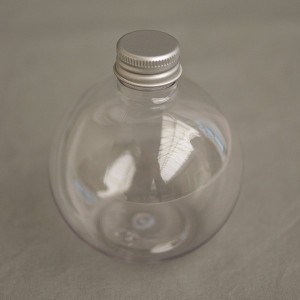
We store liquids in a bottle. So what is the most efficient shape that uses the least glass to store the most liquid?
The volume of a sphere divided by its surface area represents the greatest ratio possible of any geometrical object. We want to use the least material to construct the vessel, while it holds the most. How shall we determine what best meets our requirements?
Most Efficient Shape
We determine what best meets our requirements by logic supported by mathematics.
V/S (sphere) = 4/3пr3/4пr2 = r/3
Use, for purposes of comparison and illustration, a cube, whose dimensions are “a” on a side. Then, since its surface area is the area of its six sides,
V/S (cube) = a3/6a2 = a/6
Now since we are trying to find the most efficiently shaped vessel, we will be making all the vessels out of the same amount of, say sheet metal. So the surface areas of the vessels will be equated.
This means,
4пr2 = 6a2
or,
a = 2r√(п/6)
That means,
V/S (cube) = (r√(п/6))/3
One Example
For the simplest example, pick r = 3. Then for the sphere, V/S = 1. For the cube,
V/S (cube) = (3√(п/6))/3 = √(п/6) = 0.724
Thus, the sphere is a more efficient shape for holding liquids than the cube. A cube made with the same amount of sheet metal that a sphere is made with holds considerably less – 27.6% less!
Extending Our Understanding by Logic
A cube is a six-sided polyhedral figure. An octahedron has eight sides, but the mathematics quickly becomes much more complicated. How can we avoid having to consider mathematically polyhedra with more faces as possibly being more efficient than a sphere at holding liquids? We can do so by means of logic.
Attempt to describe the sphere as a polyhedron. Can you not visualize it as a polyhedron with an infinite number of faces the size of a point? That is one way a sphere can be described.
In fact, the more faces there are on a polyhedron, the more closely it resembles a sphere, and the more efficient it becomes at holding liquids.
Conclusion
In our discussion, we have found out that, not only that a cube and an octagon are less efficient at holding liquids, but that in the limit, the infinitely-sided polyhedron, the sphere, is the most efficient shape for holding a liquid.
Compare: Why Balloons Blow Up Round
References:
← Back to Math-Logic-Design
← Home

Logistics dictate: It’s too expensive not using the volume of empty space between spheres, therefor cubes are the common transport vessel. You could also use pyramids if force is an issue as 6 pyramids would fit in a cube.
I do not understand those equations, and hope I don’t need to. My question is why. Why is it more efficient to have more sides? (and what if the sides are concentrated on a very small area?) Intuitively, it seems to me, that the inside volume will be the same no matter what, if the perimeters (surface areas) are the same. This answer is not a matter of structural integrity correct? and can we simplify this by making it a 2-D problem? Area instead of volume? Maybe I got it. circle or sphere has (greatest number of points with) the greatest depth (or length before coming out another side)….
At first, I thought as I read your answer… What? But then… I like your way of thinking and I do believe you are starting to get it in an unusual way.